Challenges and Solutions in Australian Mining Industry Analysis
VerifiedAdded on 2021/05/31
|15
|3465
|275
Report
AI Summary
This report provides a comprehensive literature review evaluating the challenges within the Australian mining sector, focusing on the political economy and the state of the industry. It explores the impact of legislative changes, including the evolution of the legislative framework and its effects on labor relations and environmental considerations. The report also delves into the challenges faced by the Australian resources sector, such as sovereign risk perceptions, social and environmental considerations, labor and skill shortages, capital access, and foreign direct investment. It analyzes these challenges alongside potential solutions, offering insights into the industry's dynamics and future outlook. The analysis covers the role of unions, the impact of environmental regulations, and the importance of skilled labor in maintaining the sector's competitive advantage.
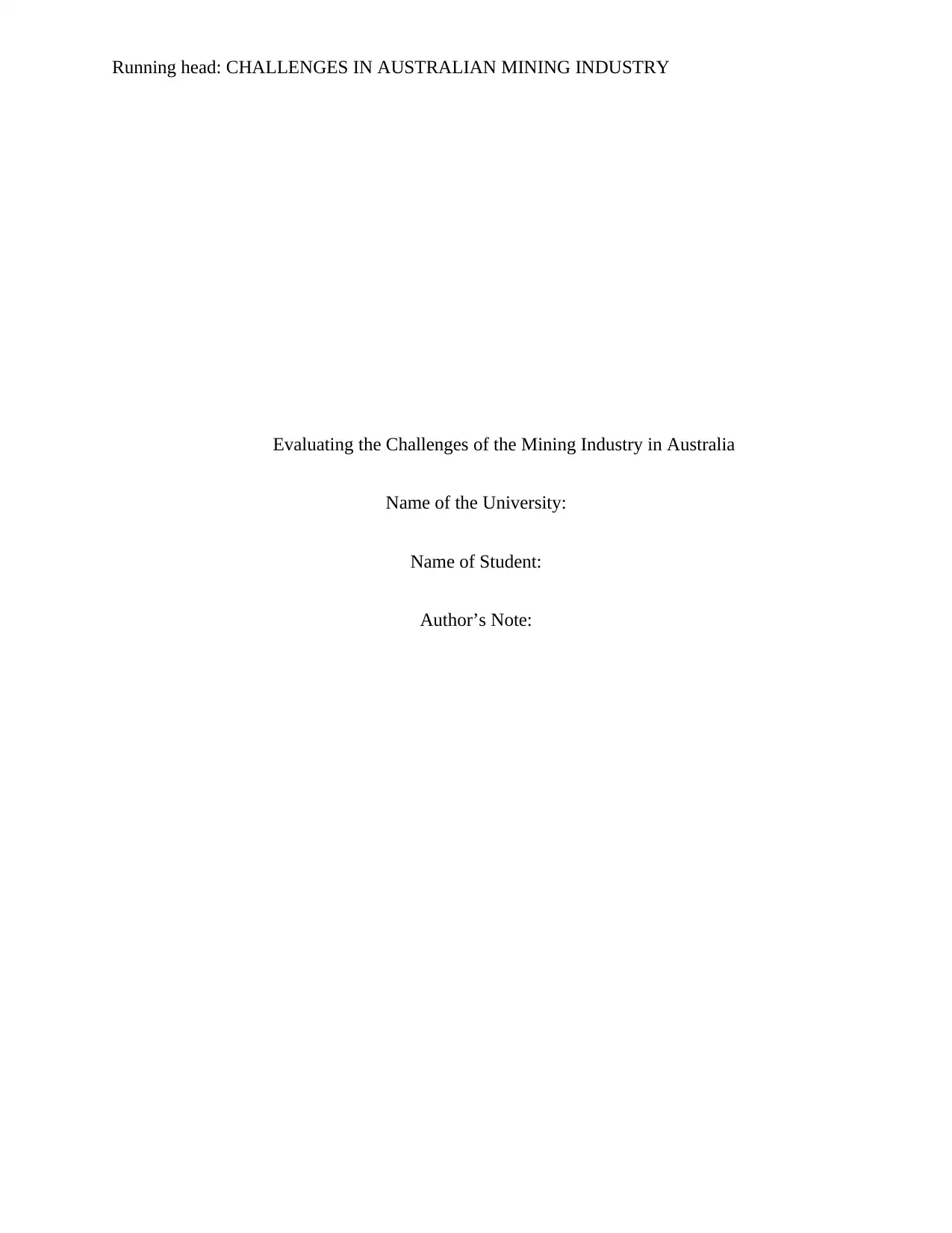
Running head: CHALLENGES IN AUSTRALIAN MINING INDUSTRY
Evaluating the Challenges of the Mining Industry in Australia
Name of the University:
Name of Student:
Author’s Note:
Evaluating the Challenges of the Mining Industry in Australia
Name of the University:
Name of Student:
Author’s Note:
Paraphrase This Document
Need a fresh take? Get an instant paraphrase of this document with our AI Paraphraser

1CHALLENGES IN AUSTRALIAN MINING INDUSTRY
Table of Contents
1. Literature Review............................................................................................................2
1.0. Introduction...............................................................................................................2
1.1. The political economy of the mining industry in Australia......................................2
1.2. The state of the mining industry...............................................................................4
1.3. Changes within a legislative framework...................................................................5
1.4. Challenges faced by Australian resources sector and solutions...............................6
1.5. Research gap.............................................................................................................8
1.6. Conceptual framework..............................................................................................9
1.7. Summary.................................................................................................................10
References..........................................................................................................................12
Table of Contents
1. Literature Review............................................................................................................2
1.0. Introduction...............................................................................................................2
1.1. The political economy of the mining industry in Australia......................................2
1.2. The state of the mining industry...............................................................................4
1.3. Changes within a legislative framework...................................................................5
1.4. Challenges faced by Australian resources sector and solutions...............................6
1.5. Research gap.............................................................................................................8
1.6. Conceptual framework..............................................................................................9
1.7. Summary.................................................................................................................10
References..........................................................................................................................12
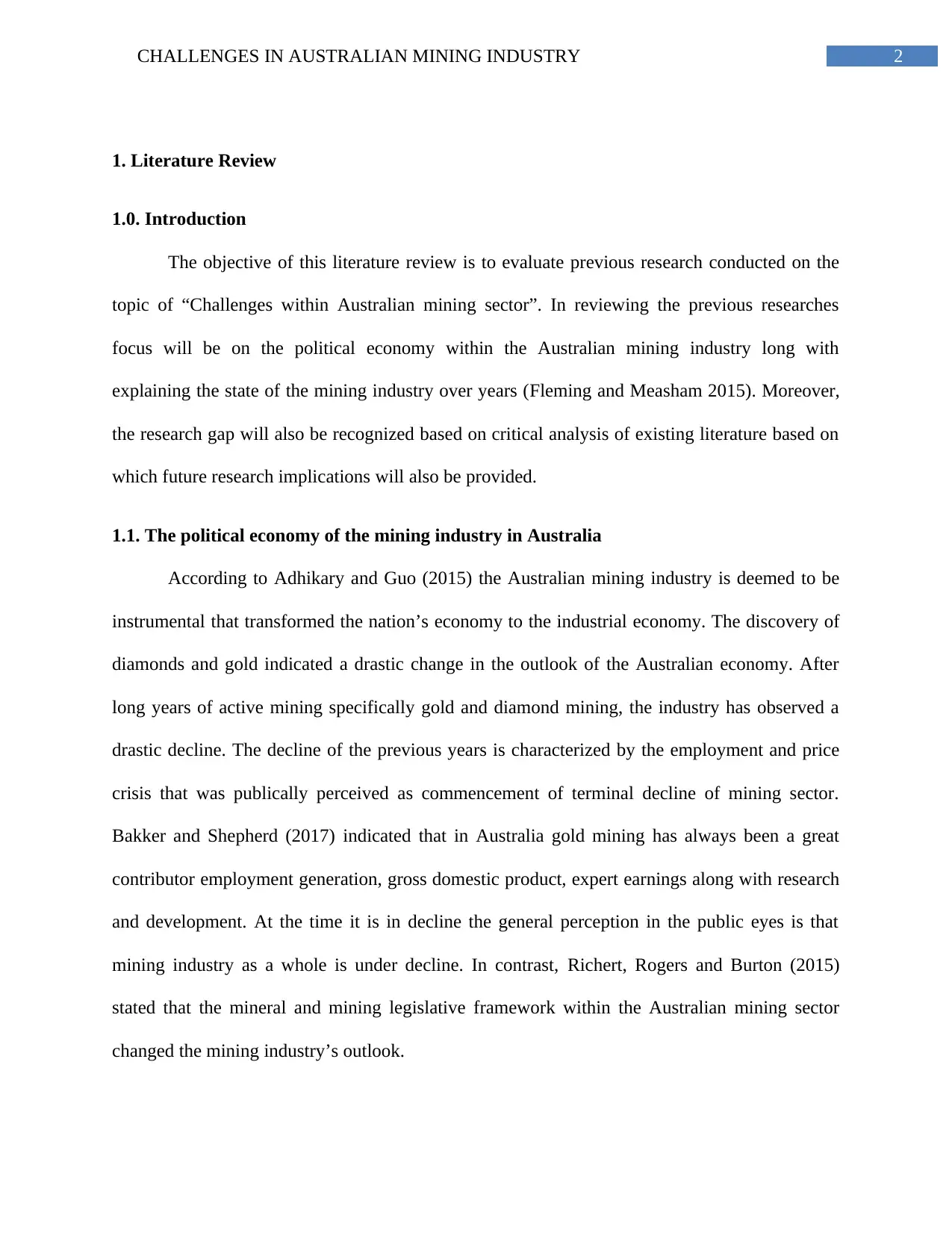
2CHALLENGES IN AUSTRALIAN MINING INDUSTRY
1. Literature Review
1.0. Introduction
The objective of this literature review is to evaluate previous research conducted on the
topic of “Challenges within Australian mining sector”. In reviewing the previous researches
focus will be on the political economy within the Australian mining industry long with
explaining the state of the mining industry over years (Fleming and Measham 2015). Moreover,
the research gap will also be recognized based on critical analysis of existing literature based on
which future research implications will also be provided.
1.1. The political economy of the mining industry in Australia
According to Adhikary and Guo (2015) the Australian mining industry is deemed to be
instrumental that transformed the nation’s economy to the industrial economy. The discovery of
diamonds and gold indicated a drastic change in the outlook of the Australian economy. After
long years of active mining specifically gold and diamond mining, the industry has observed a
drastic decline. The decline of the previous years is characterized by the employment and price
crisis that was publically perceived as commencement of terminal decline of mining sector.
Bakker and Shepherd (2017) indicated that in Australia gold mining has always been a great
contributor employment generation, gross domestic product, expert earnings along with research
and development. At the time it is in decline the general perception in the public eyes is that
mining industry as a whole is under decline. In contrast, Richert, Rogers and Burton (2015)
stated that the mineral and mining legislative framework within the Australian mining sector
changed the mining industry’s outlook.
1. Literature Review
1.0. Introduction
The objective of this literature review is to evaluate previous research conducted on the
topic of “Challenges within Australian mining sector”. In reviewing the previous researches
focus will be on the political economy within the Australian mining industry long with
explaining the state of the mining industry over years (Fleming and Measham 2015). Moreover,
the research gap will also be recognized based on critical analysis of existing literature based on
which future research implications will also be provided.
1.1. The political economy of the mining industry in Australia
According to Adhikary and Guo (2015) the Australian mining industry is deemed to be
instrumental that transformed the nation’s economy to the industrial economy. The discovery of
diamonds and gold indicated a drastic change in the outlook of the Australian economy. After
long years of active mining specifically gold and diamond mining, the industry has observed a
drastic decline. The decline of the previous years is characterized by the employment and price
crisis that was publically perceived as commencement of terminal decline of mining sector.
Bakker and Shepherd (2017) indicated that in Australia gold mining has always been a great
contributor employment generation, gross domestic product, expert earnings along with research
and development. At the time it is in decline the general perception in the public eyes is that
mining industry as a whole is under decline. In contrast, Richert, Rogers and Burton (2015)
stated that the mineral and mining legislative framework within the Australian mining sector
changed the mining industry’s outlook.
⊘ This is a preview!⊘
Do you want full access?
Subscribe today to unlock all pages.

Trusted by 1+ million students worldwide

3CHALLENGES IN AUSTRALIAN MINING INDUSTRY
The growth within the mining sector within Australia has been highly contingent on the
mining organizations that is recognized as the long term commercial interest are associated with
social responsibility and environment accountability. Sivakumar, Kannan and Murugesan (2015)
stated that this was supported by the association of a strong legislative framework that considers
the impacts of the extractive activities on the surrounding along with the affected rehabilitation,
communities along with self-regulation of the industry. The environmental protection along with
biodiversity conservation act 1999 is the overarching commonwealth legislation dealing with the
concerns of national environmental significance along with having relevance to mining.
The mineral along with petroleum resources development act of 2002 indicated vital
changes and intended to deal with several concerns. These researchers also indicated that the
political economy of Australia has always focused on the transformation of mining and mineral
sector and for maintaining the environmental sustainability of the industry. The political agencies
of the nation are also focused on the promotion of equitable access to the nation’s mineral
resources along with ensuring the promotion of investment within the exploration, mineral and
mining beneficiation. Horberry, Burgess-Limerick and Steiner (2018) stated that the objective of
such legislative framework for making sure that all the mineral rights are followed within the
state over the next five years. The promulgation of the board based socio economic
empowerment charter in consideration to the mining sector provided additional impetus for the
transformation program within the industry.
The human capital stock within the Australian mining sector has also resulted in attaining
increased competitive advantages. The major drivers behind the same were included evolution of
increasingly skilled along with experienced workforce in order to service the resource sector.
The performance of the mining sector in Australia has been underpinned not just by knowledge
The growth within the mining sector within Australia has been highly contingent on the
mining organizations that is recognized as the long term commercial interest are associated with
social responsibility and environment accountability. Sivakumar, Kannan and Murugesan (2015)
stated that this was supported by the association of a strong legislative framework that considers
the impacts of the extractive activities on the surrounding along with the affected rehabilitation,
communities along with self-regulation of the industry. The environmental protection along with
biodiversity conservation act 1999 is the overarching commonwealth legislation dealing with the
concerns of national environmental significance along with having relevance to mining.
The mineral along with petroleum resources development act of 2002 indicated vital
changes and intended to deal with several concerns. These researchers also indicated that the
political economy of Australia has always focused on the transformation of mining and mineral
sector and for maintaining the environmental sustainability of the industry. The political agencies
of the nation are also focused on the promotion of equitable access to the nation’s mineral
resources along with ensuring the promotion of investment within the exploration, mineral and
mining beneficiation. Horberry, Burgess-Limerick and Steiner (2018) stated that the objective of
such legislative framework for making sure that all the mineral rights are followed within the
state over the next five years. The promulgation of the board based socio economic
empowerment charter in consideration to the mining sector provided additional impetus for the
transformation program within the industry.
The human capital stock within the Australian mining sector has also resulted in attaining
increased competitive advantages. The major drivers behind the same were included evolution of
increasingly skilled along with experienced workforce in order to service the resource sector.
The performance of the mining sector in Australia has been underpinned not just by knowledge
Paraphrase This Document
Need a fresh take? Get an instant paraphrase of this document with our AI Paraphraser
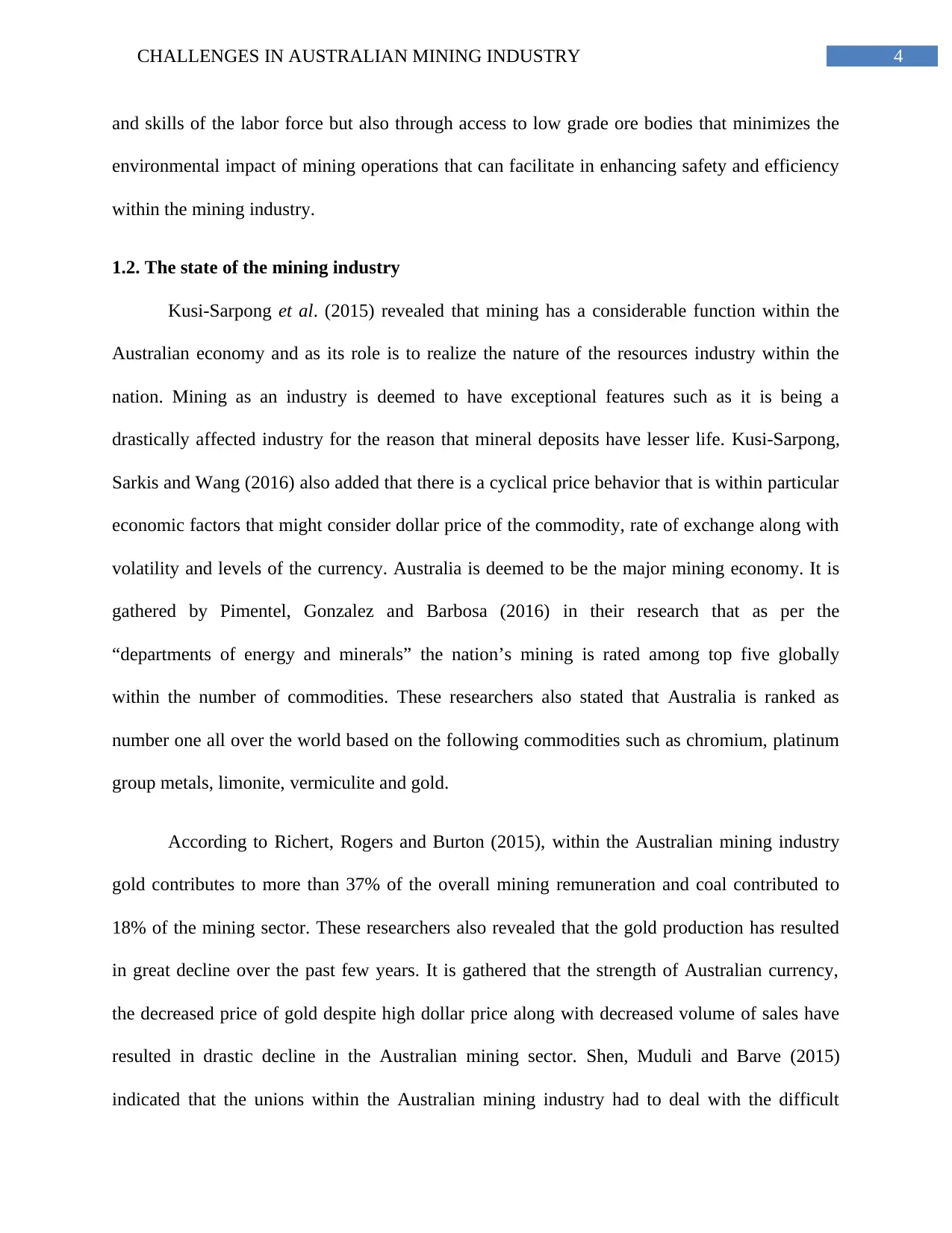
4CHALLENGES IN AUSTRALIAN MINING INDUSTRY
and skills of the labor force but also through access to low grade ore bodies that minimizes the
environmental impact of mining operations that can facilitate in enhancing safety and efficiency
within the mining industry.
1.2. The state of the mining industry
Kusi-Sarpong et al. (2015) revealed that mining has a considerable function within the
Australian economy and as its role is to realize the nature of the resources industry within the
nation. Mining as an industry is deemed to have exceptional features such as it is being a
drastically affected industry for the reason that mineral deposits have lesser life. Kusi-Sarpong,
Sarkis and Wang (2016) also added that there is a cyclical price behavior that is within particular
economic factors that might consider dollar price of the commodity, rate of exchange along with
volatility and levels of the currency. Australia is deemed to be the major mining economy. It is
gathered by Pimentel, Gonzalez and Barbosa (2016) in their research that as per the
“departments of energy and minerals” the nation’s mining is rated among top five globally
within the number of commodities. These researchers also stated that Australia is ranked as
number one all over the world based on the following commodities such as chromium, platinum
group metals, limonite, vermiculite and gold.
According to Richert, Rogers and Burton (2015), within the Australian mining industry
gold contributes to more than 37% of the overall mining remuneration and coal contributed to
18% of the mining sector. These researchers also revealed that the gold production has resulted
in great decline over the past few years. It is gathered that the strength of Australian currency,
the decreased price of gold despite high dollar price along with decreased volume of sales have
resulted in drastic decline in the Australian mining sector. Shen, Muduli and Barve (2015)
indicated that the unions within the Australian mining industry had to deal with the difficult
and skills of the labor force but also through access to low grade ore bodies that minimizes the
environmental impact of mining operations that can facilitate in enhancing safety and efficiency
within the mining industry.
1.2. The state of the mining industry
Kusi-Sarpong et al. (2015) revealed that mining has a considerable function within the
Australian economy and as its role is to realize the nature of the resources industry within the
nation. Mining as an industry is deemed to have exceptional features such as it is being a
drastically affected industry for the reason that mineral deposits have lesser life. Kusi-Sarpong,
Sarkis and Wang (2016) also added that there is a cyclical price behavior that is within particular
economic factors that might consider dollar price of the commodity, rate of exchange along with
volatility and levels of the currency. Australia is deemed to be the major mining economy. It is
gathered by Pimentel, Gonzalez and Barbosa (2016) in their research that as per the
“departments of energy and minerals” the nation’s mining is rated among top five globally
within the number of commodities. These researchers also stated that Australia is ranked as
number one all over the world based on the following commodities such as chromium, platinum
group metals, limonite, vermiculite and gold.
According to Richert, Rogers and Burton (2015), within the Australian mining industry
gold contributes to more than 37% of the overall mining remuneration and coal contributed to
18% of the mining sector. These researchers also revealed that the gold production has resulted
in great decline over the past few years. It is gathered that the strength of Australian currency,
the decreased price of gold despite high dollar price along with decreased volume of sales have
resulted in drastic decline in the Australian mining sector. Shen, Muduli and Barve (2015)
indicated that the unions within the Australian mining industry had to deal with the difficult
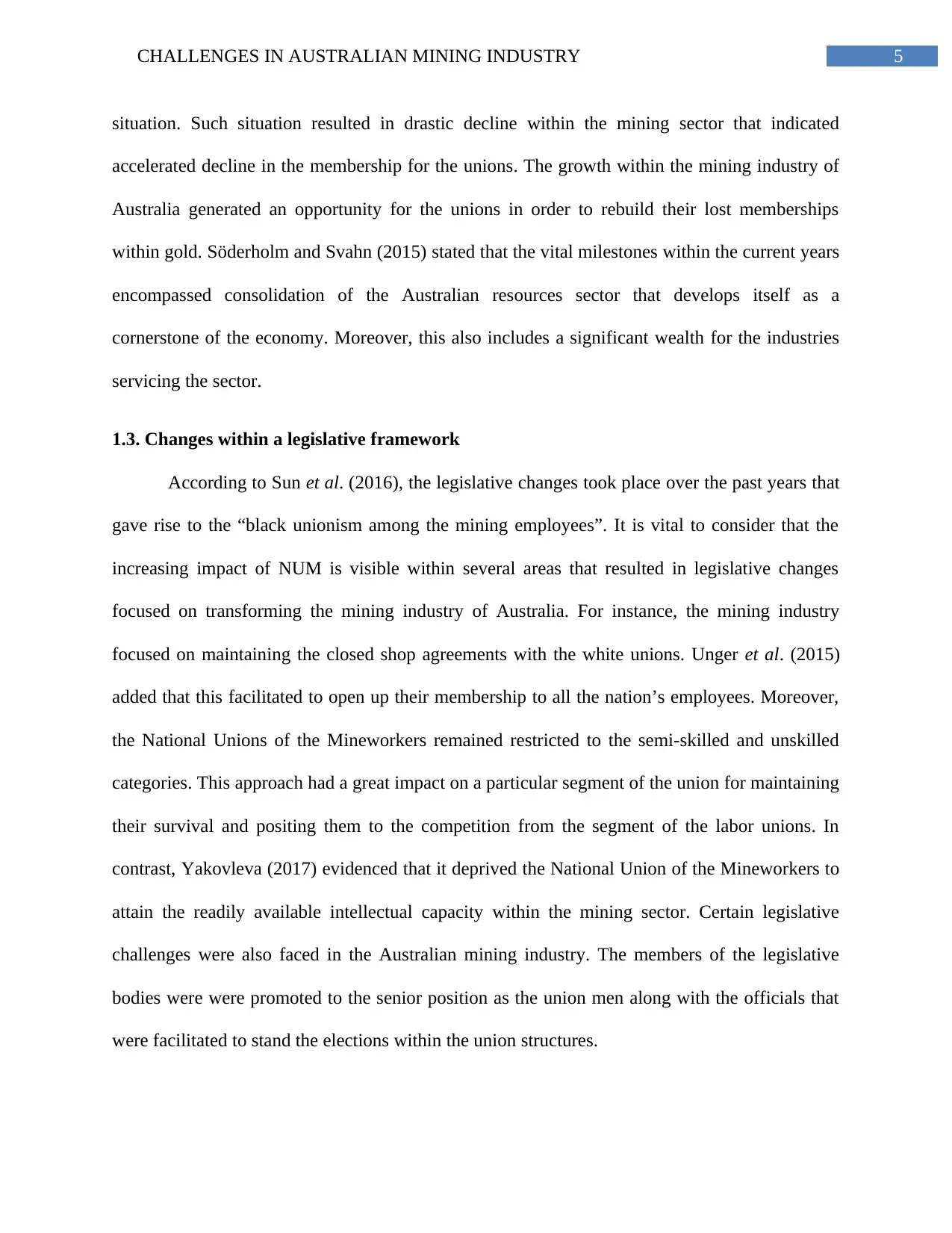
5CHALLENGES IN AUSTRALIAN MINING INDUSTRY
situation. Such situation resulted in drastic decline within the mining sector that indicated
accelerated decline in the membership for the unions. The growth within the mining industry of
Australia generated an opportunity for the unions in order to rebuild their lost memberships
within gold. Söderholm and Svahn (2015) stated that the vital milestones within the current years
encompassed consolidation of the Australian resources sector that develops itself as a
cornerstone of the economy. Moreover, this also includes a significant wealth for the industries
servicing the sector.
1.3. Changes within a legislative framework
According to Sun et al. (2016), the legislative changes took place over the past years that
gave rise to the “black unionism among the mining employees”. It is vital to consider that the
increasing impact of NUM is visible within several areas that resulted in legislative changes
focused on transforming the mining industry of Australia. For instance, the mining industry
focused on maintaining the closed shop agreements with the white unions. Unger et al. (2015)
added that this facilitated to open up their membership to all the nation’s employees. Moreover,
the National Unions of the Mineworkers remained restricted to the semi-skilled and unskilled
categories. This approach had a great impact on a particular segment of the union for maintaining
their survival and positing them to the competition from the segment of the labor unions. In
contrast, Yakovleva (2017) evidenced that it deprived the National Union of the Mineworkers to
attain the readily available intellectual capacity within the mining sector. Certain legislative
challenges were also faced in the Australian mining industry. The members of the legislative
bodies were were promoted to the senior position as the union men along with the officials that
were facilitated to stand the elections within the union structures.
situation. Such situation resulted in drastic decline within the mining sector that indicated
accelerated decline in the membership for the unions. The growth within the mining industry of
Australia generated an opportunity for the unions in order to rebuild their lost memberships
within gold. Söderholm and Svahn (2015) stated that the vital milestones within the current years
encompassed consolidation of the Australian resources sector that develops itself as a
cornerstone of the economy. Moreover, this also includes a significant wealth for the industries
servicing the sector.
1.3. Changes within a legislative framework
According to Sun et al. (2016), the legislative changes took place over the past years that
gave rise to the “black unionism among the mining employees”. It is vital to consider that the
increasing impact of NUM is visible within several areas that resulted in legislative changes
focused on transforming the mining industry of Australia. For instance, the mining industry
focused on maintaining the closed shop agreements with the white unions. Unger et al. (2015)
added that this facilitated to open up their membership to all the nation’s employees. Moreover,
the National Unions of the Mineworkers remained restricted to the semi-skilled and unskilled
categories. This approach had a great impact on a particular segment of the union for maintaining
their survival and positing them to the competition from the segment of the labor unions. In
contrast, Yakovleva (2017) evidenced that it deprived the National Union of the Mineworkers to
attain the readily available intellectual capacity within the mining sector. Certain legislative
challenges were also faced in the Australian mining industry. The members of the legislative
bodies were were promoted to the senior position as the union men along with the officials that
were facilitated to stand the elections within the union structures.
⊘ This is a preview!⊘
Do you want full access?
Subscribe today to unlock all pages.

Trusted by 1+ million students worldwide
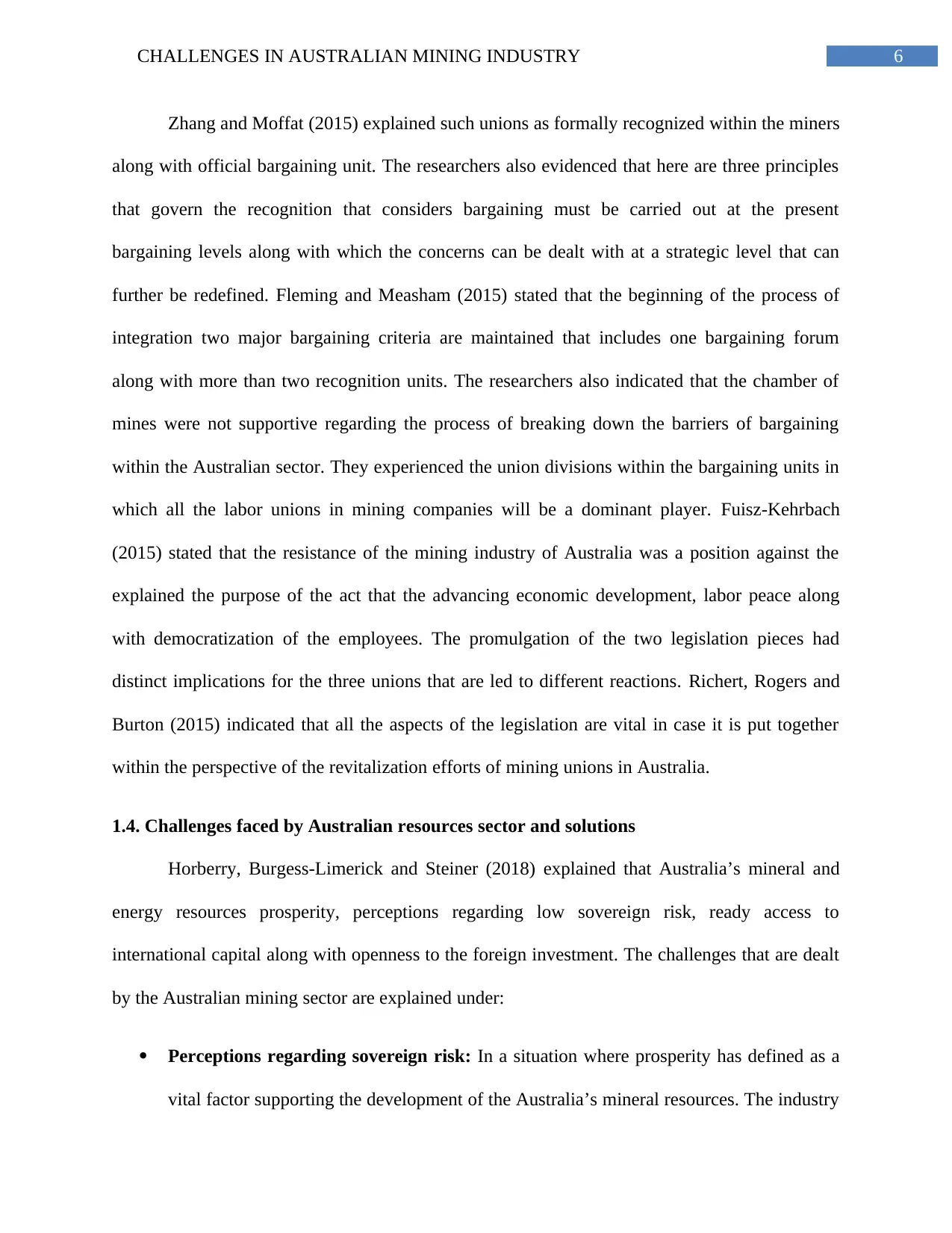
6CHALLENGES IN AUSTRALIAN MINING INDUSTRY
Zhang and Moffat (2015) explained such unions as formally recognized within the miners
along with official bargaining unit. The researchers also evidenced that here are three principles
that govern the recognition that considers bargaining must be carried out at the present
bargaining levels along with which the concerns can be dealt with at a strategic level that can
further be redefined. Fleming and Measham (2015) stated that the beginning of the process of
integration two major bargaining criteria are maintained that includes one bargaining forum
along with more than two recognition units. The researchers also indicated that the chamber of
mines were not supportive regarding the process of breaking down the barriers of bargaining
within the Australian sector. They experienced the union divisions within the bargaining units in
which all the labor unions in mining companies will be a dominant player. Fuisz-Kehrbach
(2015) stated that the resistance of the mining industry of Australia was a position against the
explained the purpose of the act that the advancing economic development, labor peace along
with democratization of the employees. The promulgation of the two legislation pieces had
distinct implications for the three unions that are led to different reactions. Richert, Rogers and
Burton (2015) indicated that all the aspects of the legislation are vital in case it is put together
within the perspective of the revitalization efforts of mining unions in Australia.
1.4. Challenges faced by Australian resources sector and solutions
Horberry, Burgess-Limerick and Steiner (2018) explained that Australia’s mineral and
energy resources prosperity, perceptions regarding low sovereign risk, ready access to
international capital along with openness to the foreign investment. The challenges that are dealt
by the Australian mining sector are explained under:
Perceptions regarding sovereign risk: In a situation where prosperity has defined as a
vital factor supporting the development of the Australia’s mineral resources. The industry
Zhang and Moffat (2015) explained such unions as formally recognized within the miners
along with official bargaining unit. The researchers also evidenced that here are three principles
that govern the recognition that considers bargaining must be carried out at the present
bargaining levels along with which the concerns can be dealt with at a strategic level that can
further be redefined. Fleming and Measham (2015) stated that the beginning of the process of
integration two major bargaining criteria are maintained that includes one bargaining forum
along with more than two recognition units. The researchers also indicated that the chamber of
mines were not supportive regarding the process of breaking down the barriers of bargaining
within the Australian sector. They experienced the union divisions within the bargaining units in
which all the labor unions in mining companies will be a dominant player. Fuisz-Kehrbach
(2015) stated that the resistance of the mining industry of Australia was a position against the
explained the purpose of the act that the advancing economic development, labor peace along
with democratization of the employees. The promulgation of the two legislation pieces had
distinct implications for the three unions that are led to different reactions. Richert, Rogers and
Burton (2015) indicated that all the aspects of the legislation are vital in case it is put together
within the perspective of the revitalization efforts of mining unions in Australia.
1.4. Challenges faced by Australian resources sector and solutions
Horberry, Burgess-Limerick and Steiner (2018) explained that Australia’s mineral and
energy resources prosperity, perceptions regarding low sovereign risk, ready access to
international capital along with openness to the foreign investment. The challenges that are dealt
by the Australian mining sector are explained under:
Perceptions regarding sovereign risk: In a situation where prosperity has defined as a
vital factor supporting the development of the Australia’s mineral resources. The industry
Paraphrase This Document
Need a fresh take? Get an instant paraphrase of this document with our AI Paraphraser
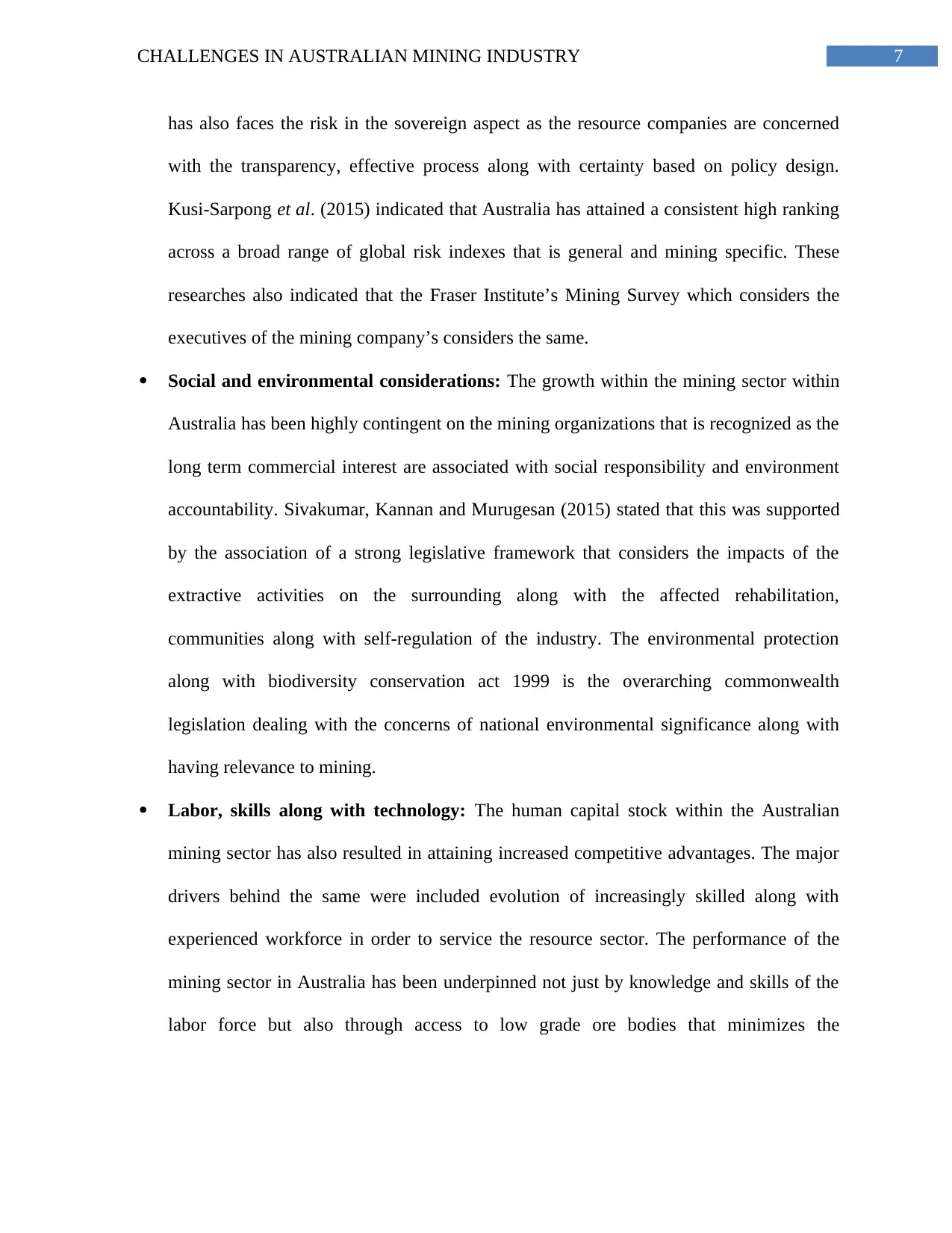
7CHALLENGES IN AUSTRALIAN MINING INDUSTRY
has also faces the risk in the sovereign aspect as the resource companies are concerned
with the transparency, effective process along with certainty based on policy design.
Kusi-Sarpong et al. (2015) indicated that Australia has attained a consistent high ranking
across a broad range of global risk indexes that is general and mining specific. These
researches also indicated that the Fraser Institute’s Mining Survey which considers the
executives of the mining company’s considers the same.
Social and environmental considerations: The growth within the mining sector within
Australia has been highly contingent on the mining organizations that is recognized as the
long term commercial interest are associated with social responsibility and environment
accountability. Sivakumar, Kannan and Murugesan (2015) stated that this was supported
by the association of a strong legislative framework that considers the impacts of the
extractive activities on the surrounding along with the affected rehabilitation,
communities along with self-regulation of the industry. The environmental protection
along with biodiversity conservation act 1999 is the overarching commonwealth
legislation dealing with the concerns of national environmental significance along with
having relevance to mining.
Labor, skills along with technology: The human capital stock within the Australian
mining sector has also resulted in attaining increased competitive advantages. The major
drivers behind the same were included evolution of increasingly skilled along with
experienced workforce in order to service the resource sector. The performance of the
mining sector in Australia has been underpinned not just by knowledge and skills of the
labor force but also through access to low grade ore bodies that minimizes the
has also faces the risk in the sovereign aspect as the resource companies are concerned
with the transparency, effective process along with certainty based on policy design.
Kusi-Sarpong et al. (2015) indicated that Australia has attained a consistent high ranking
across a broad range of global risk indexes that is general and mining specific. These
researches also indicated that the Fraser Institute’s Mining Survey which considers the
executives of the mining company’s considers the same.
Social and environmental considerations: The growth within the mining sector within
Australia has been highly contingent on the mining organizations that is recognized as the
long term commercial interest are associated with social responsibility and environment
accountability. Sivakumar, Kannan and Murugesan (2015) stated that this was supported
by the association of a strong legislative framework that considers the impacts of the
extractive activities on the surrounding along with the affected rehabilitation,
communities along with self-regulation of the industry. The environmental protection
along with biodiversity conservation act 1999 is the overarching commonwealth
legislation dealing with the concerns of national environmental significance along with
having relevance to mining.
Labor, skills along with technology: The human capital stock within the Australian
mining sector has also resulted in attaining increased competitive advantages. The major
drivers behind the same were included evolution of increasingly skilled along with
experienced workforce in order to service the resource sector. The performance of the
mining sector in Australia has been underpinned not just by knowledge and skills of the
labor force but also through access to low grade ore bodies that minimizes the
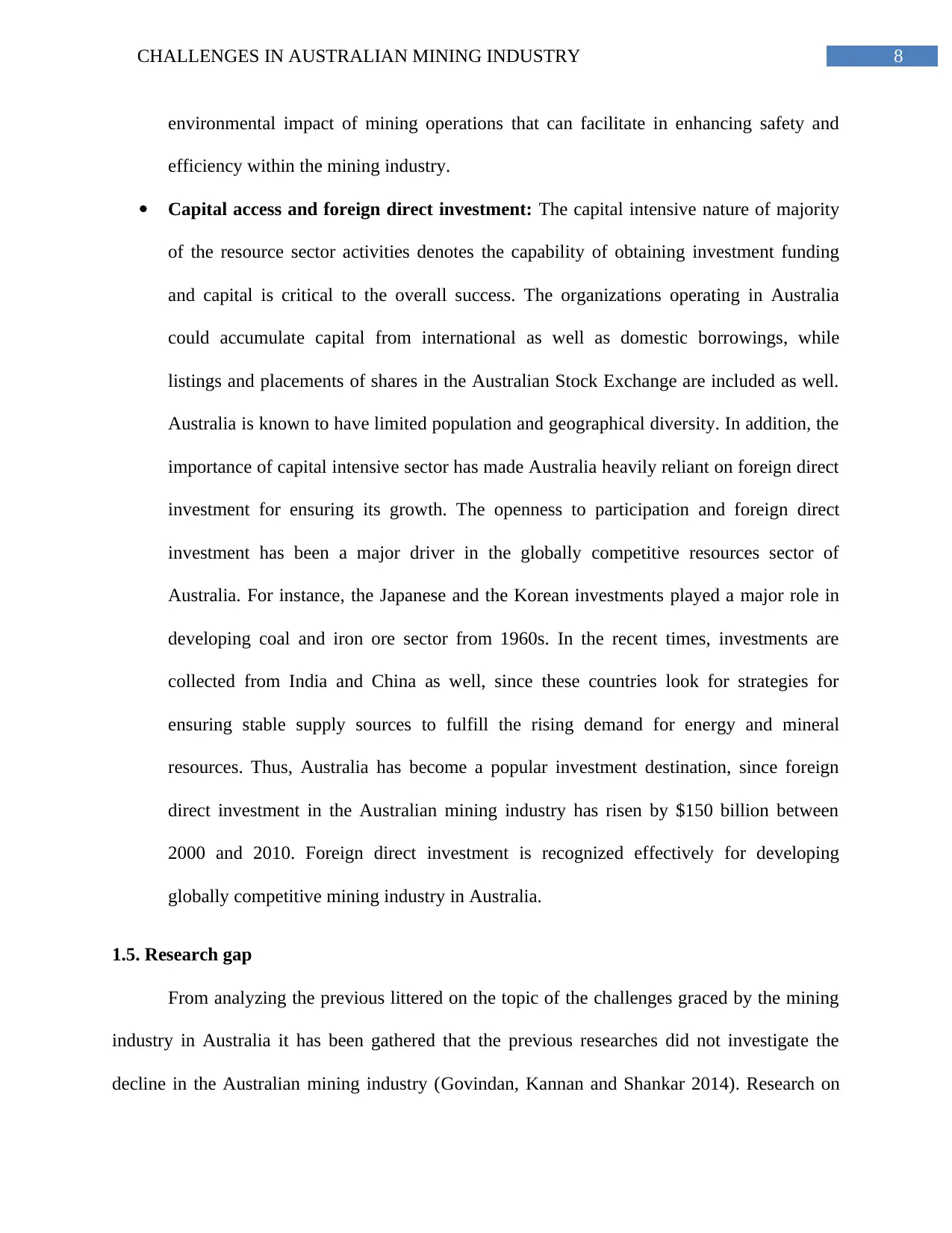
8CHALLENGES IN AUSTRALIAN MINING INDUSTRY
environmental impact of mining operations that can facilitate in enhancing safety and
efficiency within the mining industry.
Capital access and foreign direct investment: The capital intensive nature of majority
of the resource sector activities denotes the capability of obtaining investment funding
and capital is critical to the overall success. The organizations operating in Australia
could accumulate capital from international as well as domestic borrowings, while
listings and placements of shares in the Australian Stock Exchange are included as well.
Australia is known to have limited population and geographical diversity. In addition, the
importance of capital intensive sector has made Australia heavily reliant on foreign direct
investment for ensuring its growth. The openness to participation and foreign direct
investment has been a major driver in the globally competitive resources sector of
Australia. For instance, the Japanese and the Korean investments played a major role in
developing coal and iron ore sector from 1960s. In the recent times, investments are
collected from India and China as well, since these countries look for strategies for
ensuring stable supply sources to fulfill the rising demand for energy and mineral
resources. Thus, Australia has become a popular investment destination, since foreign
direct investment in the Australian mining industry has risen by $150 billion between
2000 and 2010. Foreign direct investment is recognized effectively for developing
globally competitive mining industry in Australia.
1.5. Research gap
From analyzing the previous littered on the topic of the challenges graced by the mining
industry in Australia it has been gathered that the previous researches did not investigate the
decline in the Australian mining industry (Govindan, Kannan and Shankar 2014). Research on
environmental impact of mining operations that can facilitate in enhancing safety and
efficiency within the mining industry.
Capital access and foreign direct investment: The capital intensive nature of majority
of the resource sector activities denotes the capability of obtaining investment funding
and capital is critical to the overall success. The organizations operating in Australia
could accumulate capital from international as well as domestic borrowings, while
listings and placements of shares in the Australian Stock Exchange are included as well.
Australia is known to have limited population and geographical diversity. In addition, the
importance of capital intensive sector has made Australia heavily reliant on foreign direct
investment for ensuring its growth. The openness to participation and foreign direct
investment has been a major driver in the globally competitive resources sector of
Australia. For instance, the Japanese and the Korean investments played a major role in
developing coal and iron ore sector from 1960s. In the recent times, investments are
collected from India and China as well, since these countries look for strategies for
ensuring stable supply sources to fulfill the rising demand for energy and mineral
resources. Thus, Australia has become a popular investment destination, since foreign
direct investment in the Australian mining industry has risen by $150 billion between
2000 and 2010. Foreign direct investment is recognized effectively for developing
globally competitive mining industry in Australia.
1.5. Research gap
From analyzing the previous littered on the topic of the challenges graced by the mining
industry in Australia it has been gathered that the previous researches did not investigate the
decline in the Australian mining industry (Govindan, Kannan and Shankar 2014). Research on
⊘ This is a preview!⊘
Do you want full access?
Subscribe today to unlock all pages.

Trusted by 1+ million students worldwide
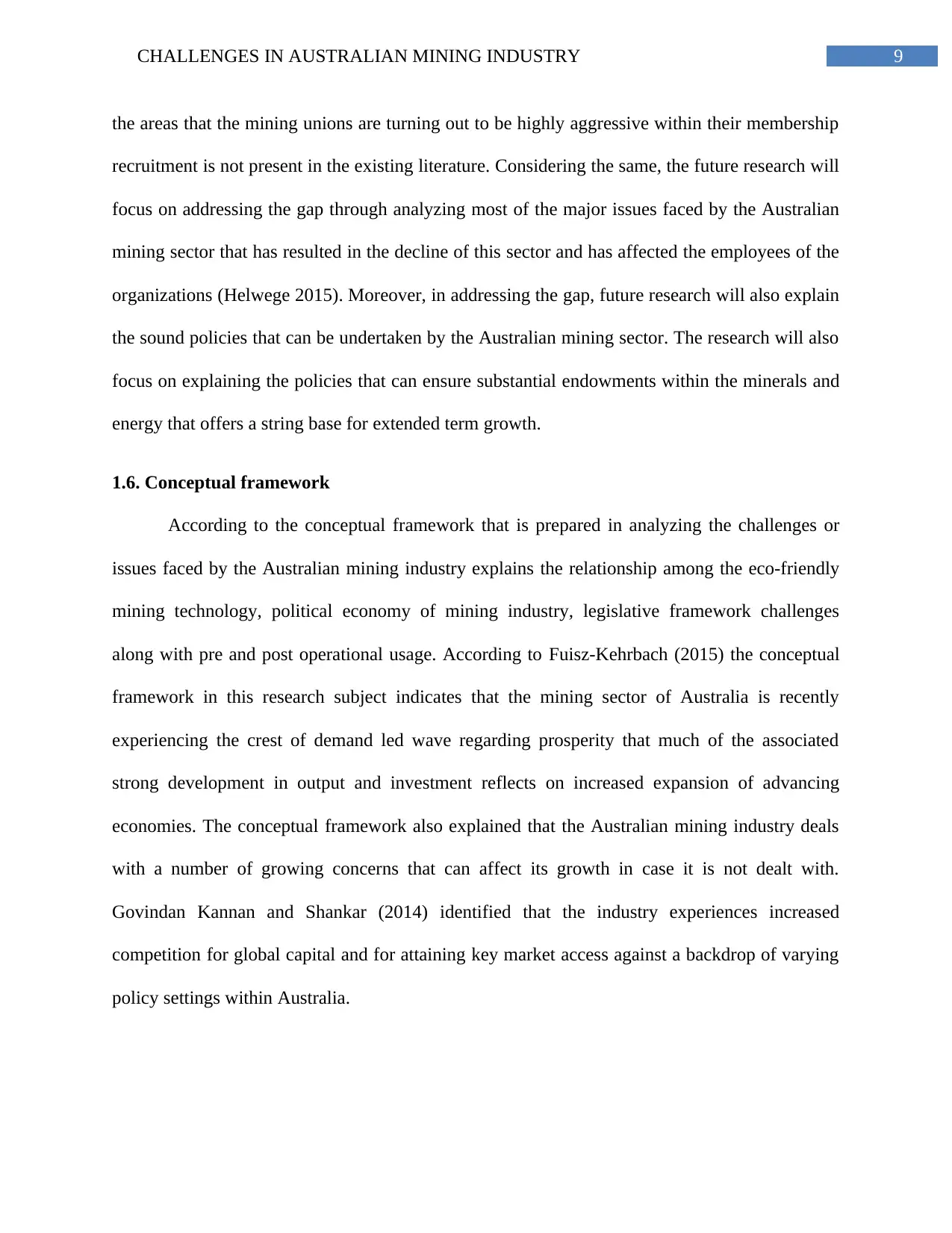
9CHALLENGES IN AUSTRALIAN MINING INDUSTRY
the areas that the mining unions are turning out to be highly aggressive within their membership
recruitment is not present in the existing literature. Considering the same, the future research will
focus on addressing the gap through analyzing most of the major issues faced by the Australian
mining sector that has resulted in the decline of this sector and has affected the employees of the
organizations (Helwege 2015). Moreover, in addressing the gap, future research will also explain
the sound policies that can be undertaken by the Australian mining sector. The research will also
focus on explaining the policies that can ensure substantial endowments within the minerals and
energy that offers a string base for extended term growth.
1.6. Conceptual framework
According to the conceptual framework that is prepared in analyzing the challenges or
issues faced by the Australian mining industry explains the relationship among the eco-friendly
mining technology, political economy of mining industry, legislative framework challenges
along with pre and post operational usage. According to Fuisz-Kehrbach (2015) the conceptual
framework in this research subject indicates that the mining sector of Australia is recently
experiencing the crest of demand led wave regarding prosperity that much of the associated
strong development in output and investment reflects on increased expansion of advancing
economies. The conceptual framework also explained that the Australian mining industry deals
with a number of growing concerns that can affect its growth in case it is not dealt with.
Govindan Kannan and Shankar (2014) identified that the industry experiences increased
competition for global capital and for attaining key market access against a backdrop of varying
policy settings within Australia.
the areas that the mining unions are turning out to be highly aggressive within their membership
recruitment is not present in the existing literature. Considering the same, the future research will
focus on addressing the gap through analyzing most of the major issues faced by the Australian
mining sector that has resulted in the decline of this sector and has affected the employees of the
organizations (Helwege 2015). Moreover, in addressing the gap, future research will also explain
the sound policies that can be undertaken by the Australian mining sector. The research will also
focus on explaining the policies that can ensure substantial endowments within the minerals and
energy that offers a string base for extended term growth.
1.6. Conceptual framework
According to the conceptual framework that is prepared in analyzing the challenges or
issues faced by the Australian mining industry explains the relationship among the eco-friendly
mining technology, political economy of mining industry, legislative framework challenges
along with pre and post operational usage. According to Fuisz-Kehrbach (2015) the conceptual
framework in this research subject indicates that the mining sector of Australia is recently
experiencing the crest of demand led wave regarding prosperity that much of the associated
strong development in output and investment reflects on increased expansion of advancing
economies. The conceptual framework also explained that the Australian mining industry deals
with a number of growing concerns that can affect its growth in case it is not dealt with.
Govindan Kannan and Shankar (2014) identified that the industry experiences increased
competition for global capital and for attaining key market access against a backdrop of varying
policy settings within Australia.
Paraphrase This Document
Need a fresh take? Get an instant paraphrase of this document with our AI Paraphraser
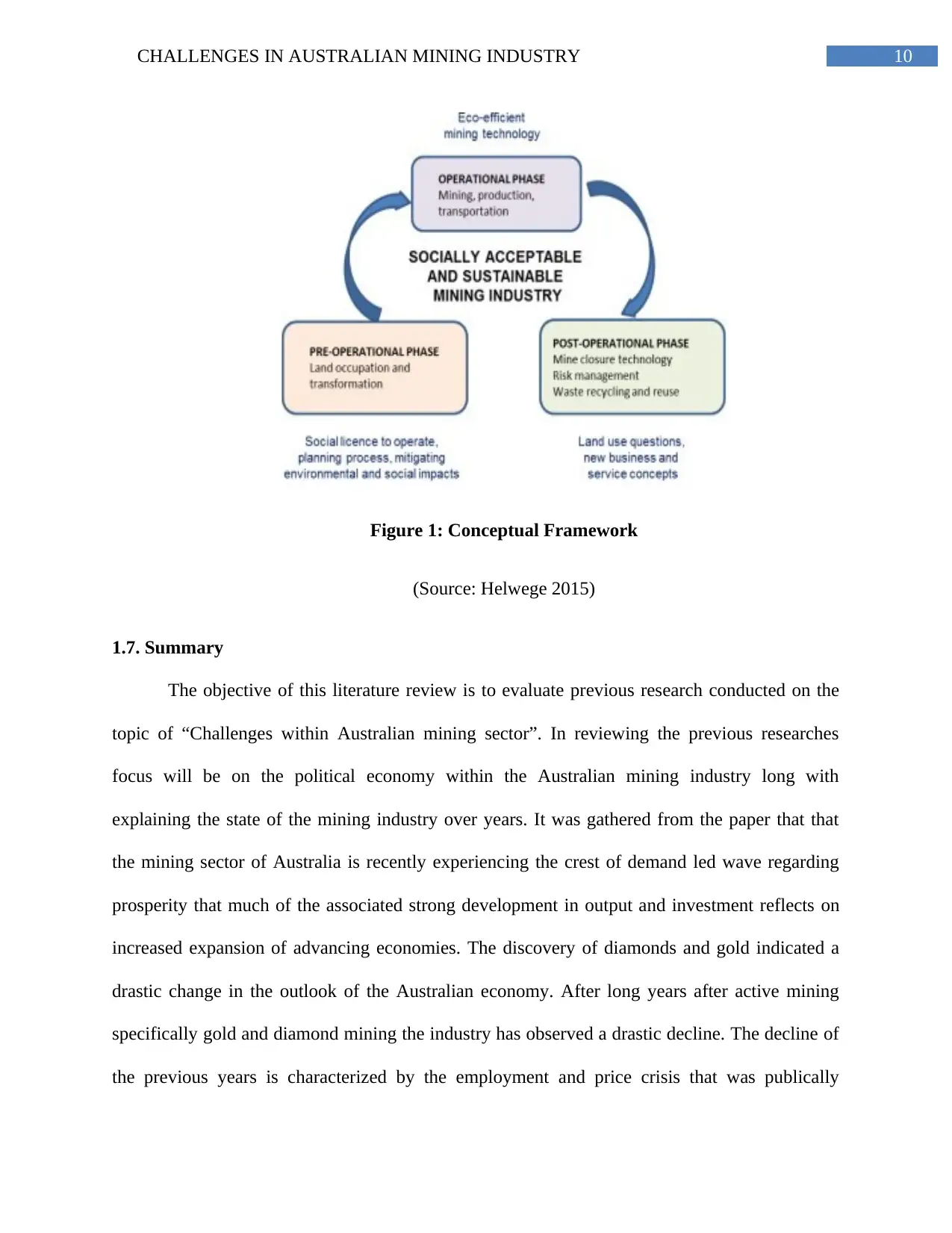
10CHALLENGES IN AUSTRALIAN MINING INDUSTRY
Figure 1: Conceptual Framework
(Source: Helwege 2015)
1.7. Summary
The objective of this literature review is to evaluate previous research conducted on the
topic of “Challenges within Australian mining sector”. In reviewing the previous researches
focus will be on the political economy within the Australian mining industry long with
explaining the state of the mining industry over years. It was gathered from the paper that that
the mining sector of Australia is recently experiencing the crest of demand led wave regarding
prosperity that much of the associated strong development in output and investment reflects on
increased expansion of advancing economies. The discovery of diamonds and gold indicated a
drastic change in the outlook of the Australian economy. After long years after active mining
specifically gold and diamond mining the industry has observed a drastic decline. The decline of
the previous years is characterized by the employment and price crisis that was publically
Figure 1: Conceptual Framework
(Source: Helwege 2015)
1.7. Summary
The objective of this literature review is to evaluate previous research conducted on the
topic of “Challenges within Australian mining sector”. In reviewing the previous researches
focus will be on the political economy within the Australian mining industry long with
explaining the state of the mining industry over years. It was gathered from the paper that that
the mining sector of Australia is recently experiencing the crest of demand led wave regarding
prosperity that much of the associated strong development in output and investment reflects on
increased expansion of advancing economies. The discovery of diamonds and gold indicated a
drastic change in the outlook of the Australian economy. After long years after active mining
specifically gold and diamond mining the industry has observed a drastic decline. The decline of
the previous years is characterized by the employment and price crisis that was publically
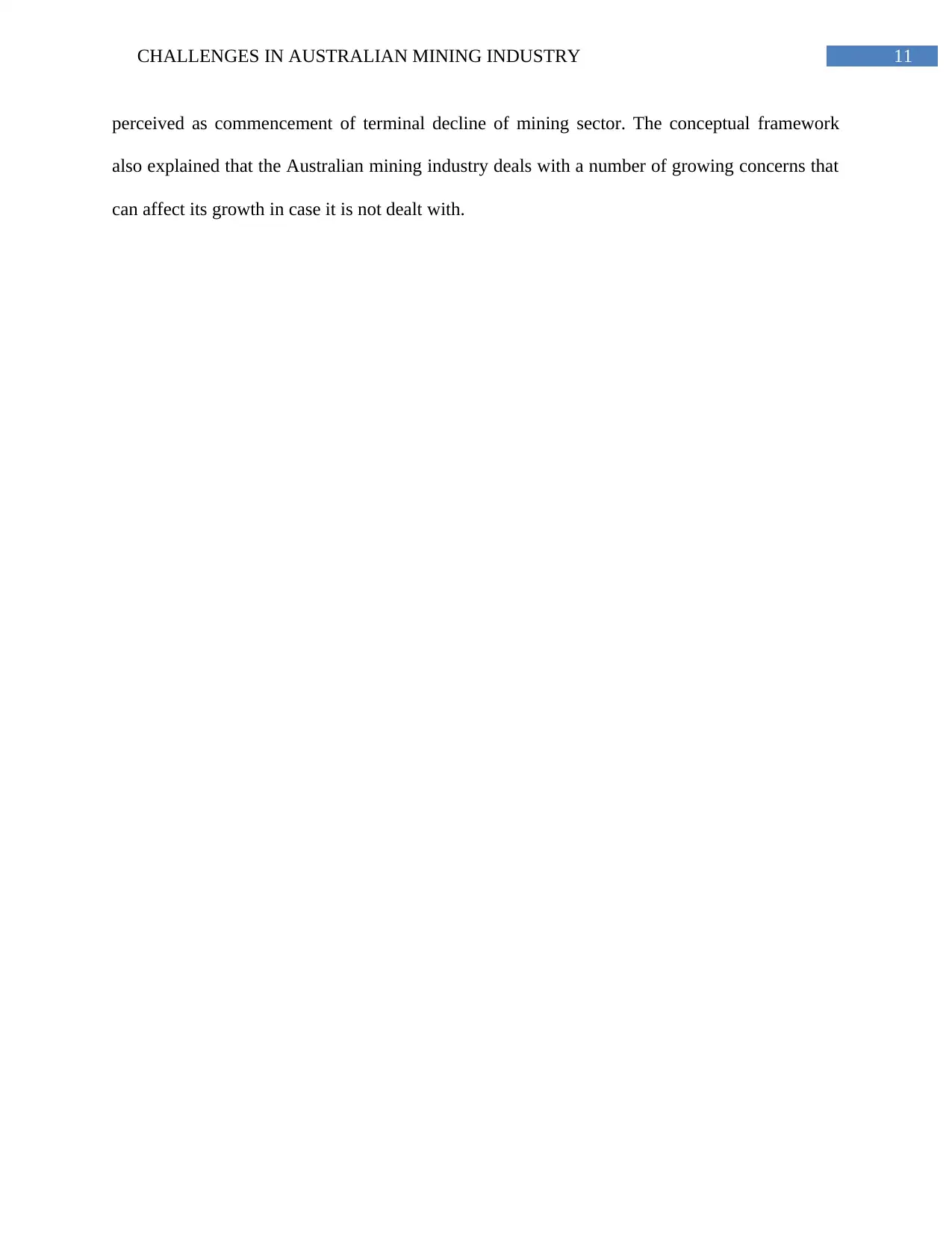
11CHALLENGES IN AUSTRALIAN MINING INDUSTRY
perceived as commencement of terminal decline of mining sector. The conceptual framework
also explained that the Australian mining industry deals with a number of growing concerns that
can affect its growth in case it is not dealt with.
perceived as commencement of terminal decline of mining sector. The conceptual framework
also explained that the Australian mining industry deals with a number of growing concerns that
can affect its growth in case it is not dealt with.
⊘ This is a preview!⊘
Do you want full access?
Subscribe today to unlock all pages.

Trusted by 1+ million students worldwide
1 out of 15
Related Documents
Your All-in-One AI-Powered Toolkit for Academic Success.
+13062052269
info@desklib.com
Available 24*7 on WhatsApp / Email
![[object Object]](/_next/static/media/star-bottom.7253800d.svg)
Unlock your academic potential
Copyright © 2020–2025 A2Z Services. All Rights Reserved. Developed and managed by ZUCOL.




